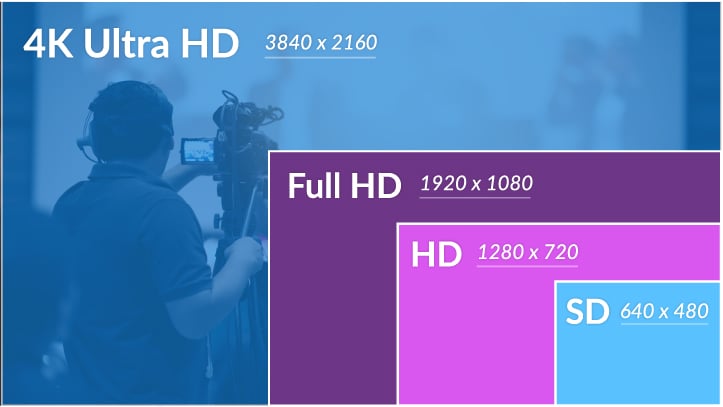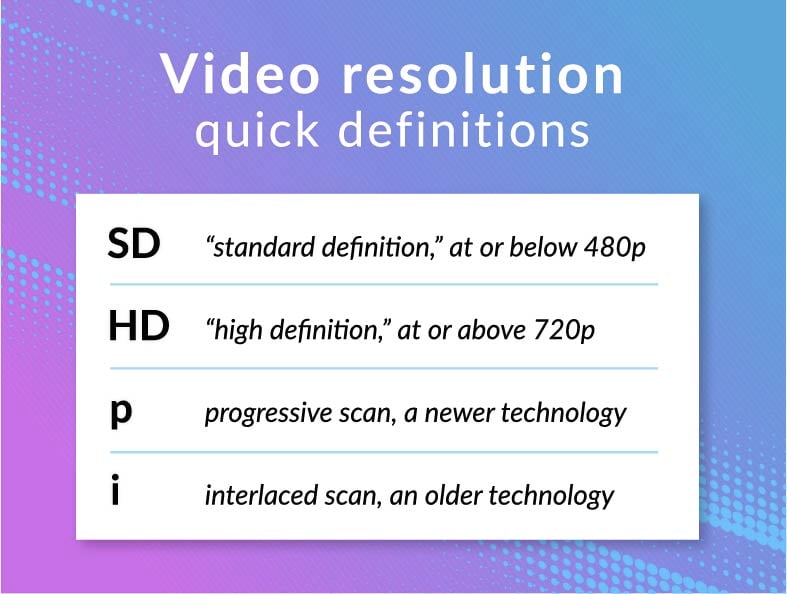
Whether you’re creating fun videos for your middle school classroom or mission-critical product demos for your business, there’s one question you can’t avoid: which video resolution is best? You might even be wondering, “What is SD vs. HD anyway? Does it even matter?”
Here’s the super-quick answer:
- SD stands for “standard definition” and includes resolutions at or below 480p.
- HD stands for “high definition” and includes resolutions at or above 720p.
And yes, video resolution definitely matters. In fact, there are more classifications out there than just SD and HD — and choosing the right resolution can make your video better for you and better for your viewers.
Let’s take a deeper look at SD vs. HD, starting at the very beginning.
What is video resolution?
To get a better handle on SD vs. HD, you have to start with the concept of video resolution itself.
Practically speaking, video resolution refers to the number of pixels contained within a frame. (Pixels are the smallest unit of color information that can be displayed on a digital screen.) Video resolution determines how sharp or clear the video appears to viewers; the higher the resolution, the more pixels it contains in a given frame and the better the image looks.
Video resolutions are commonly expressed in one of two ways:
- Width x height: For HD, this format is based on the standard aspect ratio of 16:9. Common video resolutions written in this way would include 1280 x 720 or 1920 x 1080. (SD, however, typically takes the aspect ratio of 4:3.)
- Height only*: If you’ve ever seen a video resolution written as just 720, that’s actually the shorthand version of the format just described (1280 x 720). Other resolutions frequently written this way would be 360, 480, or 1020.
*Somewhat confusingly, the highest resolutions—like 4K and 8K—are named after the width, not the height. 4K is actually 3840 x 2160 pixels.
The four most common video resolutions today are 480, 720, 1080, and 4K.

But what about the p or the i?
Ever seen video resolutions written with a letter at the end, as in 720p or 480i?
Well, those two letters provide further information about the display mode of the video and how it’s actually rendered on a screen. Here’s the difference:
- i: The i stands for “interlaced scan,” which is a technology dating back to the days of cathode-ray TVs. 1080i is still used for cable broadcasts in some countries, but otherwise, interlacing is generally considered outdated.
- p: It’s a common misconception that the p stands for “pixels.” It actually stands for “progressive scan.” Progressive scanning is a faster, newer technology that results in a sharper-looking image on the screen. Virtually all modern screens utilize progressive scanning.

Why does video resolution matter?
Although the varied naming conventions can be a bit confusing, it’s worth paying attention to resolution whenever you’re creating or editing a video. Why? Because the resolution you choose will have very practical implications for you as the video creator as well as your viewing audience.
Here’s how resolution can impact your video (and your greater brand):
- Clarity: The higher the resolution, the sharper your video will appear. Of course, sharper videos are easier to see and comprehend.
- Perception of quality: All things equal, a higher-res video tends to feel more professional and reputable.
- File size: Higher resolutions require more computer processing power and time, and they will result in a larger file.
- Bandwidth: Higher-res videos consume significantly more bandwidth, both for you streaming and your audience watching.
So while higher resolutions are generally perceived more favorably, there’s always going to be a trade-off between image quality and file size. But as we’ll see next, the question of SD vs. HD actually isn’t much of a question at all.
SD vs. HD: What is SD and is it better?
As mentioned previously, SD and HD are simply two common classifications of video resolution. SD is older and lower-resolution, while HD is newer and higher-resolution. Depending on the device you’re using and your internet speed, SD videos are much more likely to appear grainy, blurry, or pixelated.
So is SD better than HD for any reason?
The answer is, “Not really.”
Whether it’s a YouTube video, live stream, or webinar recording, viewers today expect a certain baseline of quality — and that tends to be 720 at the bare minimum. Especially as we use better devices with better screens, lower-resolution videos tend to feel outdated or even irrelevant.
Still, SD is technically good enough to get by.
480i is still the standard resolution for DVDsl. And if you’re live streaming over cell data, then SD may be the better choice, too, as HD can consume nearly 4x more data. Generally speaking, though, if you’re really asking which is better — SD vs. HD — the answer is HD all the way.
What are the other types of HD?
While SD and HD tend to be the “big bucket” classifications, there’s actually more to HD than just HD. As technology improves, there are now several distinct subsets of the HD category:
- “Regular” HD: 1280 x 720
- Full HD: 1920 x 1080
- Ultra HD: 3840 x 2160 (usually called 4K)
There are now even TVs with 8k resolution! However, almost no content is actually being created at this massive resolution (at least not yet), so 4K Ultra HD is still the gold standard for impeccable viewing quality.
Everything we discussed above regarding SD vs. HD applies to these HD classifications, too. The higher resolutions will certainly look crisper and clearer, but the trade-off will be a larger file size, more processing power, and more bandwidth.
Tips for choosing SD, HD, Full HD, or 4K
 So you've perfected your video and are about to export it from your video editor to YouTube. How do you choose the right resolution?
So you've perfected your video and are about to export it from your video editor to YouTube. How do you choose the right resolution?
Here’s a basic recommendation that will apply to the vast majority of projects:
- SD: Skip it!
- HD (1280x720): Keep this resolution as your go-to, as it provides great quality at a relatively small file size. It’s perfect for online videos.
- Full HD (1920x1080): If you need a higher resolution than standard HD, use this one. It provides better quality without massively expanding the file size.
- Ultra HD (4K): Only use 4K if you will be showing your video on a 4K device or you need cinematic quality. Otherwise the difference in sharpness is generally not noticeable enough to be worth the significantly larger file size.
Need a convenient platform to create your own HD videos for your business? WeVideo offers all three high-definition resolutions when exporting a video file: HD, Full HD, and 4K. You can get even more specific by setting the frame rate and the visual quality (both accessible under Advanced Settings).
That’s it. Video resolution may sound like an advanced topic, but you now know the essentials! Not too bad, right? All that’s left to figure out is what video you’ll make next. Try our online video editor to make it super-easy.
If you need some inspiration, here are 30 video marketing ideas you can try right now.